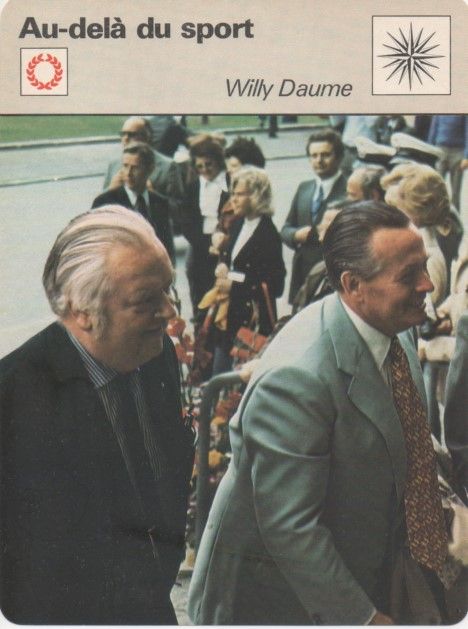This is the story of two "frères ennemis" (warring brothers) who dominated the sports shoes industry and, through their actions, precipitated the disappearance of the hypocritical amateurism.
Adolf (Adi) Dassler started his career just after WWI as a shoe repairman. He was interested in sport shoe design and he produced one of earliest spiked shoes. His elder brother, Rudolf, joined him and together, in 1924, they founded the "Gebrüder Dassler, Sportschuhfabrik" ("Dassler Brothers Sports Shoe Factory"). Already in 1928, Lina Radke, who won gold over the 800 m in the Amsterdam Olympics, wore Dassler track shoes.
But the breakthrough for the Dassler's came when they befriended the former Olympian and at the time coach of the German Olympic athletics team, Josef Waitzer. It was this relationship that gave the Dasslers access to the participants at the 1936, Berlin, Olympics. In particular Adi managed to persuade the legendary Jesse Owens to use Dassler handmade spikes during the Olympics.
I will not go into details concerning the Dasslers, their membership of the Nazi party and their war and post-war (temporary) setbacks. The interested readers can consult the corresponding, very detailed, articles in Wikipedia.
The two brothers had a fall-out in 1948 and the Gebrüder Dassler shoe company was split into two. Adolf named his' Adidas while Rudolf, initially opting for Ruda, finally rebranded his company to Puma. The fraternal rivalry was just starting.
The war between the two brother-owned companies started in earnest when Adi Dassler, sent his son, Horst (who was to found Arena in 1973, expanding Adidas' empire to swimwear), to the 1956, Melbourne, Olympic Games with the instruction to hand out free Adidas track spikes to all athletes. Although this clearly violated IOC amateur rules, Horst wagered that spikes could qualify as a technical assistance. As a result Bobby Morrow who won the 100, 200 m and the 4x100 relay appeared on the front cover of Life with Adidas shoes.
That was only the beginning. Puma's move was to pay professional football players in order to switch allegiance to them.
At the 1960, Rome, Olympics, Puma paid Armin Hary, the world record holder future olympic champion to run the 100 meters in Puma spikes. Hary did this and then he went to the podium in Adidas shoes. (Hary, was later suspended by the german federation but a that time he had practically retired following a car accident. In 1980 Hary was sentenced to 18 months in prison for abusing his real estate trader position and defrauding the Catholic Church of more than 3 million marks).
Adidas riposte to Puma came at the 1968, Mexico, Games. They managed to sign exclusive contracts with the Mexican government giving them access to the olympic village and practically preventing Puma from importing shoes into Mexico. At this point, the amateurism tzar, A. Brundage could no more turn a blind eye and continue feigning ignorance. But this is exactly what he did. Had he intervened, issuing suspensions, the U.S. athletics team would have returned home empty-handed.
The Mexico Olympics are famous for many things (see my article "Celebrating Mexico" for a refresher), but the best known, even outside the athletics circles, is the "silent gesture" on T. Smith and J. Carlos on the podium of the 200 m. What is probably less known to the public at large is that the, barefoot, sprinters placed their Puma shoes on the podium. Smith explained that "it was important for me to have them on the stand, because they helped me get there during the race and long before” (the "before" referring to the financial aid of Puma during his long months of preparation).
Adidas and Puma had greased practically everybody (including most probably olympic officials) so that nobody could be singled out and sanctioned, lest the IOC decided to take them all down. As a result nobody received a sanction.
And Brundage in all this? Well, he received a most interesting visit by none other than Horst Dassler who met him after the Games and told him "Athletes have been paid". That was not a moment of honesty on behalf of Dassler but an astute manoeuvre aiming at limiting the outrageous expenses. In fact, in trying to increase their market share both Adidas and Puma spent huge sums but just managed to keep the status quo. The only ones who profited were the athletes.
But only for a short while. In 1970, the IAAF proposed to permit the national sports federations (rather than the individual athletes) to sign commercial contracts with chosen manufacturers. So, the federations started filling their coffers with the money earned off the efforts of unpaid athletes. This hypocritical attitude, signing lucrative contracts while publicly promoting the amateur virtue and using amateurism as a criterion for eligibility to the Games could only fool everybody for a limited time. The death knell of Olympic amateurism had already sounded.








